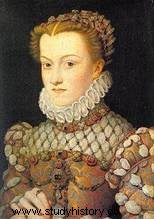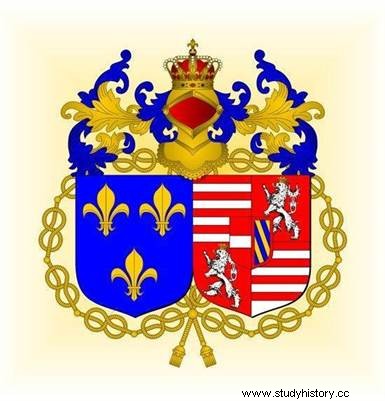 The penultimate queen of the Valois, wife of Charles IX, Elisabeth of Austria (1554-1592) was a wife gentle, kind, dominated by Catherine de Medici, self-effacing like Claudius and Eleanor; a discreet queen who is not talked about much; a queen as we loved them at that time, a queen who especially does not get involved in politics!
The penultimate queen of the Valois, wife of Charles IX, Elisabeth of Austria (1554-1592) was a wife gentle, kind, dominated by Catherine de Medici, self-effacing like Claudius and Eleanor; a discreet queen who is not talked about much; a queen as we loved them at that time, a queen who especially does not get involved in politics!
Elisabeth of Austria, a youngest in the family
Charles IX came to power by officially becoming of age on August 17, 1563. Very young, malleable and above all dominated by his mother Catherine de Medici, he was not aware of the politics and governance of a kingdom. The regent wants peace and national independence. To do this, she thinks of an alliance with the House of Austria and opts for Anne, the eldest of Maximilian II, granddaughter of Charles V.
 Marshal de Vieilleville, on a mission to Vienna in 1562, found the youngest Elisabeth, born in July 1554, "very pretty" and addresses the Emperor in these terms "Sacred Majesty, here is the Queen of France" and the young lady to transmit on her behalf to the King of France "her very humble and very affectionate service"! Catherine de Medici welcomes this news very coldly:Elisabeth is only a cadet, but archduchess all the same. A Catholic marriage is however useful and Albert de Gondi takes care of the negotiations. The contract is signed in January 1570 and the marriage by proxy takes place in October.
Marshal de Vieilleville, on a mission to Vienna in 1562, found the youngest Elisabeth, born in July 1554, "very pretty" and addresses the Emperor in these terms "Sacred Majesty, here is the Queen of France" and the young lady to transmit on her behalf to the King of France "her very humble and very affectionate service"! Catherine de Medici welcomes this news very coldly:Elisabeth is only a cadet, but archduchess all the same. A Catholic marriage is however useful and Albert de Gondi takes care of the negotiations. The contract is signed in January 1570 and the marriage by proxy takes place in October.
The young girl is sixteen years old and has learned to live at Court unlike all Spanish infantas; but no one had prepared her to have to leave her country and especially not to learn French, because in Austria she spoke German or Spanish.
Queen of France
When she arrives in France, she is welcomed in a princely manner. Like all young future spouses, Charles IX will hide in the public to watch her and while waiting for her in Mézières, he "was delighted to have found a wife in his contentment". How is she ? Fortunately, François Clouet painted her portrait:a beautiful young girl, with a triangular face, golden hair held back by a pearl headband, a frank and direct gaze. The official presentations take place on November 26, 1570, followed by the ceremonial festivities. Elisabeth is dressed in a silver dress covered with pearls and a large purple coat strewn with golden fleur-de-lis. She wears “an imperial crown adorned with large diamonds, rubies and emeralds”. The festivities last two days, the treaties are ratified, Elisabeth is Queen of France.
The festivities in the capital took place in the spring of 1571, with triumphal arches, processions, cavalcades, fireworks, balls. Sacred at Saint Denis on March 25, she was "walked" dripping with gold and pearls, in a litter of silver cloth, entered Paris on the 29th and the festivities ended on March 30, 1571 with a huge banquet and a ball offered by the City of Paris.
Of course Protestants are not happy to see so much money being spent...
Representation and procreation
Everything goes well at the beginning of the life together of the two spouses:Charles IX shows her affection when she is bedridden for a bad bronchitis in January 1571; he spends time with her, brings a troupe of jugglers there to entertain her and even takes her to the Saint Germain fair when she is better. During the Carnival period, they dress up and walk around Paris. But she does not have the same playful temperament as him and above all does not speak the same language:there is total misunderstanding! When you speak to her, you have to go through the Countess of Arenberg, a lady in her suite acting as a translator. After a year of marriage, she was pregnant...and despite Marie Touchet (the king's mistress), Elisabeth "never gave her worse dear (worse face), nor said anything worse to her, patiently supporting her little jealousy and the larceny he did to her”.
Raised in virtue and in religion, she supports her husband during the dark hours of Saint Bartholomew. Locked up alone in her apartments, almost all alone sleeping in the Louvre, when the tocsin starts ringing, and these women warn her to tell her that her husband is responsible, she begins to pray for him and ask God to forgive!
 On October 27, 1572, a little Marie-Elisabeth was born, carried by the godmother the Queen of England during the baptism .
On October 27, 1572, a little Marie-Elisabeth was born, carried by the godmother the Queen of England during the baptism .
Elisabeth is mentioned once again during the visit of the Polish ambassadors in 1573:she only makes an act of presence. During the three and a half years of reign, she was sidelined by her husband who preferred hunting and her mother-in-law power. Yet when her husband is sick, she stays with him, sitting in silence, crying while hiding her pain, praying a lot, even at night so as not to be seen.
The return to Vienna of Elisabeth of Austria
After the death of her husband in 1574, "not being recognized or gratified as she deserved", she resolved to return to Austria, not being able to stay in France because she has no children. In Amboise, she will kiss her granddaughter whom she will not see again and who will die in April 1578, then leaves Paris at the beginning of December 1575. She settles down again in Vienna, she is only twenty-one years old! She remains in good contact with her sister-in-law Marguerite (Queen Margot) to whom she will pay half of her dower when she learns that the Queen of Navarre no longer has a "valiant penny".
Henry III is approached for her new husband:she refuses; Philip II of Spain has just lost Anne (the eldest of the archduchesses), they offer him Elisabeth:she also refuses, in memory of her husband Charles.
Wishing to enter the convent, she founded a monastery of Poor Clares near Vienna. She leads the life of nuns “in vigils, fasts and continual prayers for peace between the Christian princes”. She created the Church of All Saints in Prague and may have written two books “on the Word of God” and “on the significant events that happened in France in her time”.
She died in January 1592 and L'Etoile wrote "she had been much loved and honored by the French".
Simone Bertière – The bloody years – the queens of France in the time of the Valois. Pocket, 1996.
